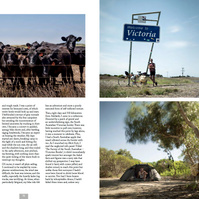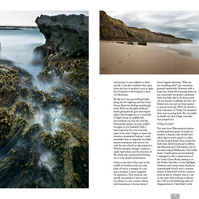boobies, chips and humans – evolution in the galapagos
February 22, 2015Type ‘The Galapagos Islands’ into Google maps and click ‘street view’. The image to appear is, without doubt, what most people would imagine when asked to collate their knowledge of the archipelago and visualise it – a scrubby, nondescript landscape, a thousand kilometres from anywhere and littered with large, guano covered boulders. Perched atop the rocks and scattered in between, strange seabirds with unimaginably blue feet - so blue, in fact, that the white feathers of their chests are turned the same unreal hue- , stare back with a slightly dazed, uninhibited gaze. Chuck in a faded info-panel with a few poorly researched facts about Charles Darwin, finches and the theory of evolution and you have yourself a fairly accurate depiction on some levels – thank you Google for the tour, and 360° of it at that. However, if you were to leave your internet-aided exploration, put on your adventure boots, board a plane and then another plane and then another plane and then… another plane, some 45 hours later you would find yourself flying high above a patch of the world where there is so much more than just rocks, strange animals and revolutionary theories.
Seeing the Galapagos Islands from the sky, on one of the very few flights a day, must surely be one of life’s greatest delights. The water is crystal clear, deep and intensely turquoise. It crashes up against rugged coastlines, bordered with black, volcanic rocks, uninterrupted except for the occasional pale, sandy and completely pristine and deserted beach. The lowlands, almost devoid of vegetation and beaten by a hot sun, are truly martian-like whereas further inland, ascending high above the coast and shrouded with low lying cloud, lies the damp, mossy and impenetrable interior. At sea level, far in the distance and barely visible even on the clearest of days, is the next island in the chain, hinting at another wondrous world entirely.
Quite famously, a collection of endemic animals call this place home. Sea lions, blue footed boobies, red footed boobies, marine iguanas, flightless cormorants,giant tortoises, penguins, great frigate birds, finches, lava lizards - the list goes on and on - each more remarkable and unique than the next. One might think that the remoteness of the archipelago would mean these animals have the place to themselves. However, as with so many nooks ‘off the beaten track’ in our modern world, 25,000 locals call the island chain home and almost 200,000 sightseers pop by for a visit each year, creating the need for souvenir stores, pizza restaurants and magnum ice creams. Fortunately, the locals are contained in three towns and the tourists are limited to 60 strictly monitored locations, with the remaining land - 97.5% - labeled national park and left almost completely inaccessible. Not that the animals take any note of park signs and boundaries. Whether it is because they are naturally highly personable, or it is just a blatant miscalculation of the danger, but the native animals certainly have no qualms meeting and greeting the humans.
The crumpling sound of a chip packet opening brings out Darwin’s famous finches in volumes. Hopping quickly around people’s feet and, when the opportunity presents itself, landing on people’s hands and heads, no stray crumb is left discarded. In the right part of the island chain and with a plucky personality, beak size matters less and less in our modern world.
The great frigate birds, in the absence of seagulls, willingly snap up any piece of fish thrown their way. With their black plumage, bright red gullets and huge, two metre wingspan, the frigates are an imposing seabird and, due to them rarely landing, there is a knack to the game of feeding them. Any food thrown their way is not simply tossed to the ground, instead it must be lobbed high into the air, allowing the birds hovering just above head height, to swoop down and snatch it up – slightly more thrilling than feeding a rabble of squabbling gulls.
More sedately and almost like a glimpse into the Jurassic era, marine iguanas reside amongst the volcanic rocks lining the heavily populated beaches. Despite the rocks being quite a human thoroughfare from beach to beach, the iguanas will remain happily sun baking, shaking their heads gently and silent except for the occasional violent sneeze as they expel a plume of salty spray from their nostrils - quite a beautiful site when backlit by the setting sun. They only amble slowly out of the way if a tail or toe is in danger of being stepped on.
Then of course, there are the sea lions. They are surely the first animal to be noticed because they are, quite literally, everywhere. Great collections of them, groaning and burping, are scattered on beaches, on walkways, in between boats, in front of cars, at the base of steps, out the front of the police station - keeping watch beside the officer on duty - , and on any bench not claimed by a human buttocks first. They cheekily use tourists’ beach towels as their own, include snorkelers and scuba divers in their games of tag, catch waves with far greater ease than any of the sunburnt, water-pruned, dreadlocked surfers and approach, wide grinned and sand-covered, to within tantalisingly pattable distances - causing problems for anyone trying to respect the ranger imposed rule of remaining at least 2 metres from the wildlife. Then, when it all becomes too much - the tourist got too close, the towel wasn’t big enough, the best bench was being used by an elderly local, the game of tag had grown boring – the sea lions show their dominance and, with a bark and a snort, give chase. There is nothing quite like the sound of an unsuspecting tourist’s cries of terror as an overweight, screaming sea lion charges up the beach towards them.
The Galapagos Islands is a wondrous place. It has an incredible and world redefining history, today it is magical, hilarious and truly stunning and, with any luck and a great deal of care, it will also have a future.





